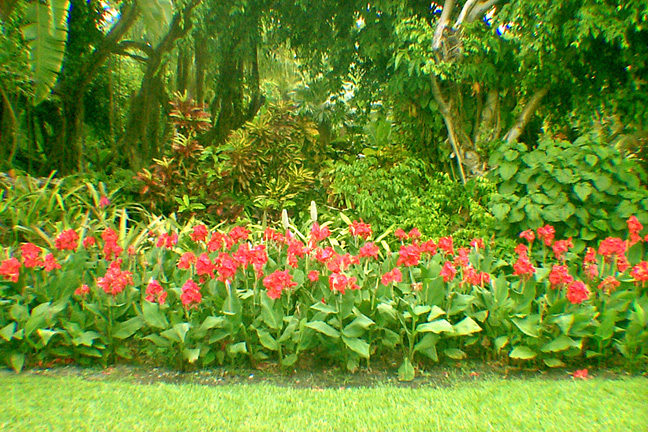
Canna Lilies for South Florida

Not many plant families can boast year round color like the Canna Lily. These relatives of the Heliconias, Bananas, and Birds of Paradise are easily grown in South Florida.
For full sun locations the red, yellow, or orange flowers lend a colorful accent to any garden or patio. Even the foliage comes in different colors. Although usually green, some plants will have red or variegated leaves. Unfortunately, lush beds of Canna lilies are an uncommon sight in our region.
Growing Cannas is very labor intensive; maintaining healthy plants requires almost daily care. Our high humidity encourages fungi and high year-round temperatures offer insects perfect breeding conditions. Below are some of the difficulties of growing Cannas along with some of the solutions to those problems.
Fungi
The fungal problems affect both the foliage and the flowers. An orange looking rust often appears on the leaves and stems of the plants. These are the fruiting bodies of a fungi commonly called Frangipani rust. When this rust first appears, the foliage that it is on must be removed and discarded (if you leave it there you will be allowing the fungi to propagate). The best method for fungal control is prevention and sanitation. However, flowable copper (which is copper in a liquid form) can be sprayed on the stems and foliage (top and bottom of the leaf) to help prevent fungal problems before they occur. Although used commercially, copper is not practical for home use because of its toxicity.
The flowers are sometimes affected by a gray, fuzzy mold called Botrytis. Under humid conditions it is often found growing on the older flowers. Remove the old flowers so the mold does not spread to the new flowers.
Leaf Rollers
The worst and most obvious insect problem is a caterpillar called a "leaf roller". This is the culprit that devours the leaves. During the day they reside on the underside of the leaf inside a little hammock that they make when they cut out a portion of the leaf and curl it over themselves and glue it to the leaf above. They are active at night and, if allowed to grow unchecked, will eventually strip the plant of all its foliage. Control of these caterpillars can be achieved by using a spray that contains the ingredient Bacillus thuringiensis. This compound is supposed to be nontoxic to mammals and birds. It is quite effective when applied with a spreader sticker to the undersides of the leaves. (Any chemical applied to the underside of a leaf will probably last longer because there is less exposure to water and sunlight) The use of a commercial spreader sticker (an agent that helps break down the leaf's waxy cuticle) is important because the leaves of the Canna lily are very waxy; that makes it difficult for anything to stick. A household detergent will also do (usually two tablespoons to a gallon of spray).
Floral Thrips
These tiny insects can be seen without a magnifying glass. They are dark, slender and about the length and size of the lead showing on a sharpened pencil. They suck the juices of the flowers causing them to wilt. Thrips are sometimes found on orchid flowers. An effective control that is harmless to the plants can be achieved by removing all the flowers from all the Canna Lilies on site at the same time. This usually has to be done only once.
Spider Mites
These microscopic members of the spider family make their living by sucking the sap out of plants. Damage from spider mites first appears as yellowing of the leaves. If this damage is left unchecked, the plants will eventually die. Spider mites are first found on the undersides of the leaves, although they can end up covering up the entire plant. About the size of the head of a pin, they are easy to see with a magnifying glass. They may be white but some of the common species have red dots, hence the 2-Spotted Spider Mite. Common insecticides are useless; commercial miticides are more effective, but the best home control is removal of the food source. As a leaf begins to die (senesce), the nitrogen within it becomes more nutritious for the mite. Since the lower leaves are the oldest, cutting the lower leaves of the plant eliminates this valuable food source.
Snails
The introduced Cuban Brown Snail also causes damage to the foliage and flowers. A commercial snail bait is effective. However, removal of all debris under and around the plants will eliminate daytime hiding places for these nocturnal mollusks, usually eliminating the need for snail bait.
General Horticulture
Full sun and soil high in organic material will produce vigorous plants. A good rule of thumb is to allow Cannas to bloom only twice; removal of the entire plant stem at this point will remove fledging populations of insects. Do not wet the foliage. Water the plants at ground level - this will help prevent fungal problems. Fertilize often. Cannas grow rapidly and respond well to a balanced fertilized (20-20-20 et.) and, remember, keep the plant bed clean.





 About Tropical Plants
About Tropical Plants Giving your Garden the Tropical Look with Epiphytes
Giving your Garden the Tropical Look with Epiphytes Exotic Plants for Butterfly Gardens
Exotic Plants for Butterfly Gardens Canna Lilies for South Florida
Canna Lilies for South Florida